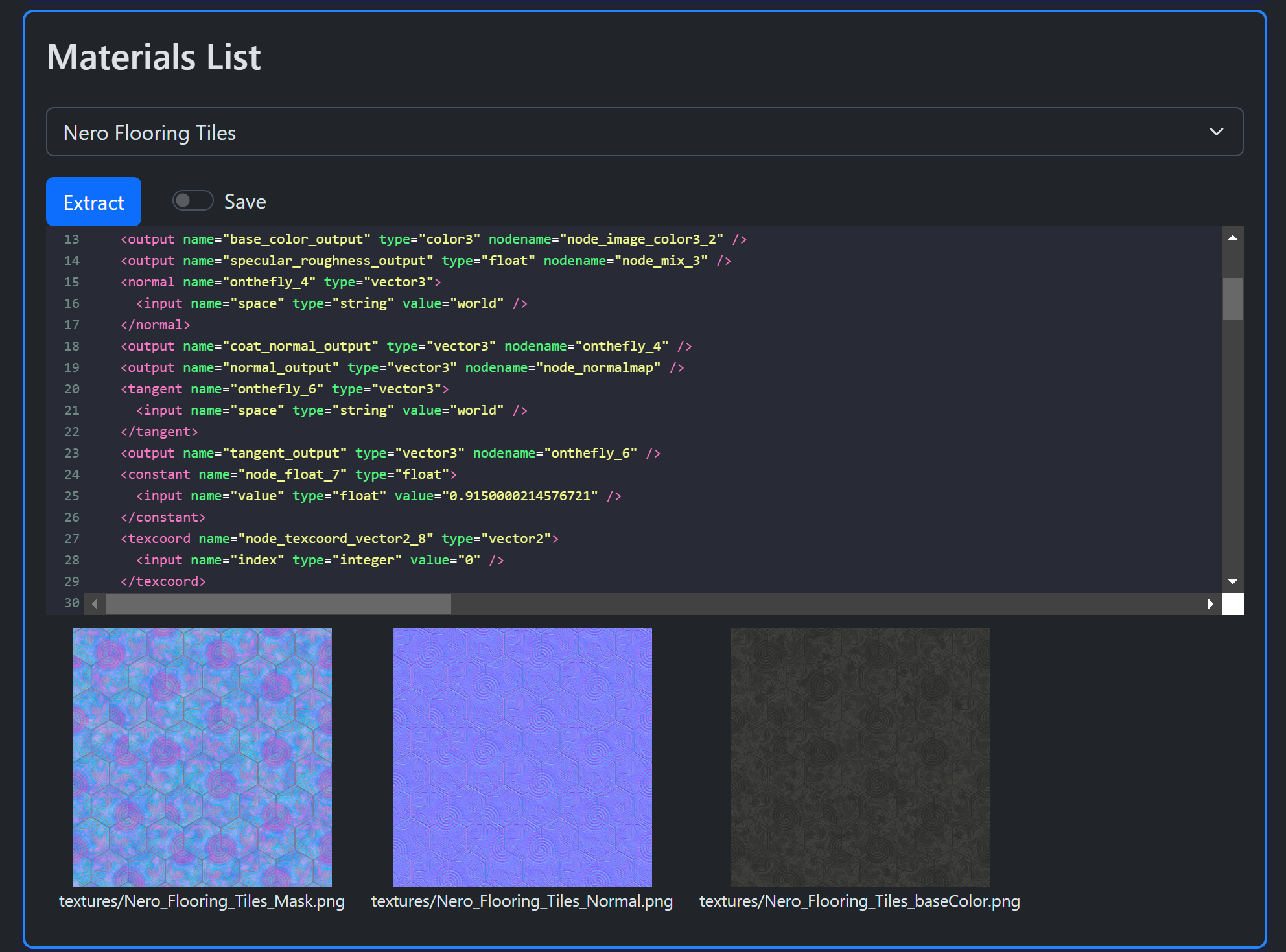 MaterialX Materials
MaterialX Materials
Introduction
Welcome to MaterialX Materials.
This site hosts a set of libraries and utilities to query remote databases for materials which can
either be mapped to MaterialX materials or are natively stored in that format.
Last Updated: September, 2025
Links
- Home Page
GitHub repository.
- Related utilities and libraries can be found at:
MaterialXLab
Utilities
 PhysicallyBased database Material descriptions can be downloaded with additional utilities to create materials using either: Autodesk Standard Surface, OpenPBR, or glTF PBR shading model shaders.
PhysicallyBased database Material descriptions can be downloaded with additional utilities to create materials using either: Autodesk Standard Surface, OpenPBR, or glTF PBR shading model shaders.
 AMD GPUOpen database MaterialX packages can be downloaded (as zip files). Images and MaterialX documents can be extracted for any of the posted materials in the database.
AMD GPUOpen database MaterialX packages can be downloaded (as zip files). Images and MaterialX documents can be extracted for any of the posted materials in the database.
 ambientCG database MaterialX packages can be downloaded (as zip files). Images and MaterialX documents can be extracted for any of the posted materials in the database.
ambientCG database MaterialX packages can be downloaded (as zip files). Images and MaterialX documents can be extracted for any of the posted materials in the database.
Each currently has PolyHaven Library MaterialX assets can be downloaded (as zip files). Images and MaterialX documents can be extracted for any of the posted materials in the database.
PolyHaven Library MaterialX assets can be downloaded (as zip files). Images and MaterialX documents can be extracted for any of the posted materials in the database.
PythonorJavascriptimplementations.Usage Examples
1. PhysicallyBased
An interactive page for extracting
PhysicallyBaseduses a Javascript implementation found here
2. AMD GPUOpen
A command line utility is available here. This usesNode.jsto allow access to fetch materials from theGPU Opensite(which is not available via a web page).A Flask application is also available which uses the Python package with a Web based front here.

3. ambientCg
A NodeJS / Express application can also be found on the MaterialXWeb site.
This is designed to be a general purpose MaterialX material inspector supporting
ambientCgandGPUOpencurrently with the intent to add new libraries as they become available.
4. PolyHaven
A Python library and command
polyHavenLoaderandpolyHavenLoaderCmdare currently available which can
produce a filtered list of assets (textures) which have
MaterialX representations. This list cna be used to download
specific assets and save to zip format.A Javascript library and Web interface is available here. Filtering by classification, name tags, and dependent image resolution is available. Materials may be previewed and / or saved.



Loading into Web Editor
Below are screenshots of materials fetched from
PhysicallyBased,GPU Open,ambientCg>andPolyHaven(left to right images respectively).Note that the material zip from
GPU OpenandambientCgis directly read into the editor via it's zip loading option.PolyHavenbuilds a zip to allow loading via the zip loading option.



Library Dependencies
The Python utilities require:
- The MaterialX 1.39 or greater package for PhysicallyBased OpenPBR shader creation. The current build is against 1.39.4.
- The
requestspackage. - The
pillowpackage for image handling for GPUOpen package handling
The GPUOpen Javascript logic requires:
node-fetchif fetch is not available in the version of Node.js used.yargsfor the command line utility
Package Building
The
GitHub repository can be cloned.
The Python package can be built using:
pip install .This will pull down the dependent Python packages as needed.
Build scripts can be found in the
utilitiesfolder.build.shwill install the package and run package commands to update package data.buildDocs.shwill prepare documents and run Doxygen to build API docs.
The GPUOpen Javascript utility requires Node.js to be installed. From the package folder (
javascript\JsGPUOpenLoaderPackage) the following should be run:npm install # Install dependent packages npm run build # Setup runtime areaUsage
Python Commands
-
Query all materials fom PhysicallyBased and convert them to all support shading models. Save the material list and corresponding MaterialX files in the default output location. The build will include this information Python package under the
datafolder.python physicallyBasedMaterialXCmd.pyor
materialxMaterials physbased -
Query all materials fom GPUOpen. Extract out a few material packages (zip). Save the material lists, material names and unzipped packages (MaterialX and images) in the default output location. The build will include this information Python package under the
datafolder.materialxMaterials gpuopen --materialNames=1 --saveMaterials=1 -
Download the materials list fom ambientCG:
materialxMaterials acg --saveMaterials True -
Extract out a material package for the "WoodFloor038" material from ambientCG requesting the
package where the images are 2K PNG files:materialxMaterials acg --downloadMaterial "WoodFloor038" --downloadResolution 2 -
Examine all texture assets on PolyHaven, and find all ones which have MaterialX resources. Does not download the asset.
polyHavenLoaderCmd.py --fetch --download_id="" -
Extract out a specific MateriaX asset with a given identifier.
polyHavenLoaderCmd.py --fetch --download_id="aerial_asphalt_01" -
Extract out the first 10 MaterialX assets.
polyHavenLoaderCmd.py --fetch -c 10 -
Scan locally downloaded MaterialX asset information to download.
python -m materialxMaterials polyhaven --load --download_id="aerial_asphalt_01"
GPU Open Node.js Utility
The utility can be run from the
javascript\JsGPUOpenLoaderPackagefolder as follows:npm start -- [<arguments>]or:
node gpuOpenFetch.js [<arguments>]with the appropriate arguments. It supports the same options as the Python utility -- namely material information, and package (zip) downloads. For the following 2 lines are equivalent to download a material called "Moss Green Solid Granite".
node gpuOpenFetch.js -n "Moss Green Solid Granite" npm start -- -n "Moss Green Solid Granite"Library
A
Jupyternotebook demonstrates the direct usage of the Python library. The output of the notebook can be found here. The notebook can found in the Github repository under theexamplesfolder.Results
The following are some samples which have been rendered using the
MaterialXViewutility which is part of the MaterialX binary distribution.Examples
Details about some examples can be found in the Examples pagesEmerald Peaks Wallpaper Indigo Palm Wallpaper Oliana Blue Painted Wood 


Ketchup Cooking Oil Brass 


The rows of materials are from `GPUOpen` `PhysicallyBased`, and `ambientCG` and `PolyHaven` from top to bottom respectively.Metal (53) Paving Stones (142) Wood Floor (38) 





API Reference
The API reference can be found here